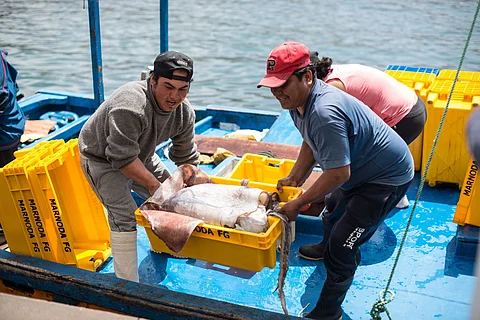

Peruvian fishermen landing jumbo flying squid.
Photo: Produce.
According to information provided by the Peruvian Ministry of Production (Produce), fish landings for direct human consumption grew by 63.9% in April in Peru, reaching 151.4 thousand tons. This represents a slight increase of 1.36% over the 153.5 thousand tons landed in March.
In April, as was the case last month, this growth was also driven by a higher extraction of resources destined for the frozen industry (+188.5 %) and for fresh consumption (+2.9 %).
"The increase in landings of jumbo flying squid (+540.3%), bonito (+15.9%), skipjack (+20.3%), shrimp (+10.4%) and mullet (+8.4%) contributed significantly to the positive performance of the direct human consumption fishery in the fourth month of the year," noted Peru's Minister of Production, Sergio González.
If we talk about the cumulative year, from January to April 2025, the increase in landings of resources destined for direct human consumption was 39%, again due to the increased extraction of resources destined for the frozen industry (+80.9%), mainly jumbo flying squid, horse mackerel, fan shell and shrimp.
In addition, there was an increase in the availability of catches for fresh consumption (+7.1 %), as well as for the canning (+18.3 %) and curing (+8.0 %) industries.
Regarding the contribution of the fisheries sector to the country's Gross Domestic Product (GDP), Produce estimated that, in April, the extractive and processing sector contributed PEN 497 million (EUR 120.5 million / USD 137.4 million), or 1.0% to the national GDP.
As mentioned, the species that contributed most to the growth of fish landings for direct human consumption in Peru in April was the jumbo flying squid. Also known as Humboldt squid (Dosidicus gigas), this species is being one of the protagonists in 2025 in Peru.
Key to the economy of the South American country, the jumbo flying squid fishing activity involves 4,475 artisanal vessels, and generates direct employment for more than 14,000 fishermen, benefiting some 70,000 people in Peru. Therefore, this year, the Ministry of Production has not only approved a new regulation to ensure its sustainability but also recently extended the total allowable catch (TAC) for the first fishing period of 2025.
Initially set at 190 tons, a few days ago, Produce announced that the TAC would be increased by 100,000 tons to 290,000 tons, while the extraction period would be extended to August 31 of this year.
The Peruvian Ministry of Production took this measure following the technical and scientific evaluation of the Peruvian Institute of the Sea (Imarpe), which confirmed the high availability of the resource and recommended such adaptation to allow its sustainable exploitation.
"This technical decision allows optimizing the responsible use of a strategic resource for the country, providing stability to the fishing sector and generating greater economic opportunities, especially for coastal regions. We are taking care of a fishing economy that does not stand still," said the Vice Minister of Fisheries and Aquaculture, Jesús Barrientos.
As mentioned above, the jumbo flying squid is one of Peru's most important hydrobiological resources, both in terms of catch volume and in terms of generating employment and foreign exchange through the export of value-added products.
